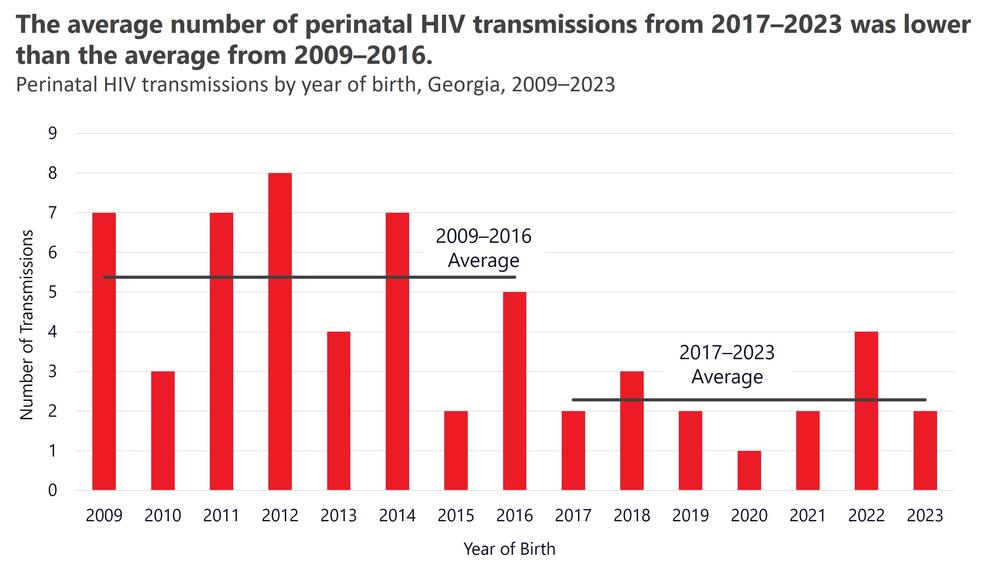
Perinatal Exposure Surveillance
The Georgia Department of Public Health (GA DPH) conducts surveillance of perinatal HIV exposure, which is defined as any infant whose mother has tested positive for HIV regardless of the infant’s HIV status. Perinatal HIV exposure surveillance has been conducted in Georgia since 2016. Approximately 200–250 women with HIV giving birth are identified each year.
- It is mandatory for healthcare providers and laboratories to report perinatal HIV exposure (see the Disease Reporting Page and Georgia Code O.C.G.A. § 31-12-2). For infants whose mother has tested positive for HIV, all infant labs from birth to 18 months must be reported and a Pediatric Case Report Form completed within seven (7) days. See the Case Reporting Page for details on reporting for both healthcare providers and laboratories.
Vertical Transmission Surveillance: As part of perinatal HIV exposure surveillance, GA DPH monitors the occurrence of vertical HIV transmission, which is the transmission of HIV from mother to infant during pregnancy, labor and delivery, or postpartum through breastfeeding.
Without any intervention, the risk of HIV transmission from mother to infant ranges from 15-45% (see Reference #1 below). However, the risk of transmission can be reduced to less than 1% when appropriate preventative action is taken (see Reference #2 below). Successful prevention of vertical transmission of HIV requires interventions that span the pregnancy, labor and delivery, and postpartum periods. This coordinated effort is critical to ensure that no infant is perinatally infected with HIV.
Assessing Adherence to Guidelines and Opportunities for Outreach: As part of perinatal HIV exposure surveillance, GA DPH aims 1) to understand if the guidelines for prevention of perinatal transmission are implemented and 2) to identify opportunities for outreach to improve health outcomes for the mother and baby during pregnancy, labor and delivery, postpartum, and beyond.
Vertical Transmission Trends in GA: The figure below shows overall improvements in the prevention of vertical transmission of HIV in recent years, likely due to increased efforts in improving patient follow-up and provider adherence to proper guidelines in caring for women during pregnancy, labor and delivery, and the postpartum period.

Perinatal HIV Clinical Guidelines
Recommendations for the use of antiretroviral drugs during pregnancy and interventions to reduce perinatal HIV transmission are available at Clinical Info | HIV.gov.
The Perinatal HIV Hotline is a federally funded service that provides clinicians with advice on indications and interpretations of HIV testing in pregnancy, and consultation on antiretroviral use during pregnancy, labor and delivery, and the postpartum period. It is available at 1-888-448-8765, 24 hours a day, 7 days a week.
Additional DPH Information:
- Information on DPH’s Perinatal HIV Program, their resources, and services can be found at Women’s Health – HIV.
- Information on HIV testing requirements for pregnant women in Georgia can be found at
DPH’s Serologic Testing Requirements for Pregnant Women .
History of Enhanced Perinatal Surveillance (EPS)
Perinatal HIV exposure surveillance was previously conducted in Georgia through CDC's Enhanced Perinatal Surveillance project from 2005–2010. It was an extension of routine HIV and AIDS surveillance activities to evaluate prevention of perinatal HIV transmission, and screening and treatment interventions for infants born across all of Georgia (population-based), then later for infants born at seven Regional Perinatal Centers throughout Georgia (facility-based). Georgia resumed EPS in 2016, using lessons learned to improve upon the initial EPS work, and returning to the population-based surveillance method in Georgia.
Perinatal HIV Exposure Surveillance Data
-
Reports
This annual report aims to provide a demographic breakdown of mothers with HIV who gave birth during that calendar year, interventions done to prevent vertical HIV transmission, and figures regarding the mother’s HIV status including diagnosis and viral suppression. The report also provides an estimated rate of vertical transmission of HIV in Georgia for the given year, based off confirmed vertical transmission cases.
-
Presentations
The presentations provide an overview of key findings from the annual surveillance reports with accompanying figures.
More Information
Case Reporting: For instructions on how to report HIV and AIDS cases and lab reports, see HIV and AIDS Case Reporting.
How To Request Data: To request data beyond what is included on the GA DPH website, please visit PHIP Data Request to create a PHIP data request account and complete the data request form.
References:
- World Health Organization, Mother to Child Transmission of HIV; https://www.who.int/teams/global-hiv-hepatitis-and-stis-programmes/hiv/…
- Introduction: Recommendations for the Use of Antiretroviral Drugs During Pregnancy and Interventions to Reduce Perinatal HIV Transmission in the United States; https://clinicalinfo.hiv.gov/en/guidelines/perinatal/introduction?view=…;
Page last updated 10/23/2025